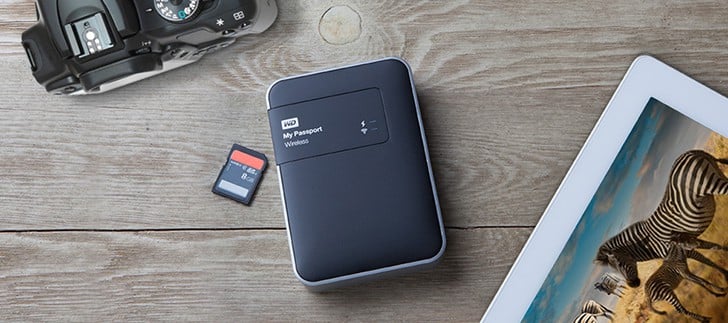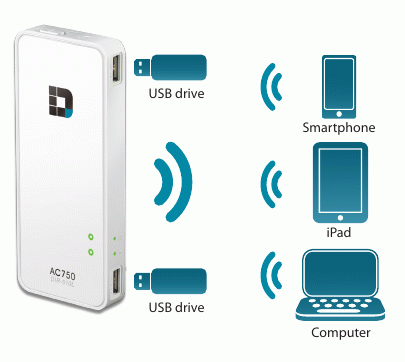Portable USB hard disks make it easier to carry terabytes of data on the go. You can access your data at any time by plugging the drive into a computer. But sometimes you might be required to share the data on your external hard drive with multiple devices at the same time. Each person may simultaneously want to interact with different files on the same hard drive. For instance, let’s say your portable USB hard drive contains a number of different types of files, each of which need to be accessed by multiple people in the room. Of course, one way would be to connect the external hard drive to each of the individual computers and manually copy the required items, but surely it’s not the most feasible way, is it?
Also, as more smartphones come with bigger screen sizes, watching videos and movies on smartphones has become quite a trend. Some smartphones ship with limited internal storage, with no SD card support. As such, people might want to access media content from an external hard drive on their smartphones, to serve as expandable memory. Now, all smartphones don’t have USB OTG (On The Go) capability, a feature that allows you to access an external USB hard drive on a smartphone by plugging into it. And even if the feature is supported, it is not always feasible to carry around a portable hard drive connected to a smartphone via OTG cable.
Instead, a more suitable solution would be to set up a Wireless LAN (hotspot) and allow other devices to access the content of your external drive from a shared location. That way, multiple WiFi enabled devices connected to the wireless hotspot, would be able to simultaneously access and stream different content from a hard drive; that too, without the help of any additional accessory, such as an OTG cable. In this article, we’ll explore different ways you can share your external hard drive contents wirelessly over WiFi.
There are primarily two ways you can share data from an external hard drive:
- Using a WiFi enabled portable hard disk.
- Using a WiFi router with USB storage support.
Wireless external hard drives
Some of the popular hard drive manufacturers such as Western Digital, Seagate, Kingston, etc. manufacture portable wireless hard drives that allow you to share and stream data over WiFi. The hard disk creates its own WiFi hotspot where other WiFi enabled devices can connect to and access the drive’s data. As with other typical WiFi hotspots, there is a limit to the number of hosts that can connect to the wireless drive. But that number varies depending on the product.

Types of wireless hard drives
There are different types of wireless drives available depending on how you want to use it. Thus, you should consider a few things before you get a wireless hard drive. You’ll usually find three basic types of wireless hard drives available in (online as well as brick-and-mortar) stores:
Portable wireless hard drives: These are usually small in size and easy to carry, but they also have storage limited to a few hundred gigabytes. These portable wireless drives are meant for quickly accessing and sharing important data on the go. If you are an individual who needs to frequently share important data with friends or colleagues, this type of wireless hard drives should be suitable for you.
External hard drives with wireless support: These are similar to the usual USB external hard drives, but in addition to USB, they also have support for creating WiFi hotspots. These devices can range between a number of storage sizes – from a few hundred gigabytes to terabytes of storage. These are usually portable as well and useful when you have to access and share relatively large amounts of data on the go.
Wireless backup drives: These usually have storage space up to several terabytes and are useful for taking full backup of your data. They come in handy in situations when you have multiple computers in your home and you want to keep complete backups of all your devices. Being a dedicated backup solution, you won’t have to worry about storing your backup on individual computers, since backups stay on the external backup drive. Also, since the storage may be accessed by multiple devices at once, you can use the same backup copy to simultaneously restore multiple devices.
Additionally, wireless hard drives provide different ways of sharing data over WiFi. Some of them let you access data through official smartphone apps, while others provide access to a specific network path in the WLAN.
Popular wireless hard drives
Kingston Wi-Drive (WID)
Wi-Drive is a truly portable external hard drive that can simultaneously share content with up to three devices. It provides access to drive contents via the official Wi-Drive app, which is available on App Store, Google Play and Kindle Fire. It does not require any external source to power it up and uses a rechargeable battery that supports up to four hours of continuous use. Available in 32GB, 64GB and 128GB variants and supported on the iPhone, iPad, iPod Touch, Android phones and tables and Kindle fire devices. The Wi-Drive might be a suitable solution for the limited storage issue on smartphones, such as iPhone, Moto X, Nexus devices, etc.
Seagate GoFlex Satellite Wireless
GoFlex Satellite lets you stream media content and other files from the hard drive to up to three WiFi enabled devices simultaneously. It is powered with a rechargeable battery that can support up to 5 hours of continuous usage. It comes in a 500GB variant and supports Mac and Windows platforms and also has official apps available on Apple App Store and Google Play.
Seagate Wireless Plus
Seagate Wireless Plus is similar to GoFlex Wireless but it comes in three different storage variants – 500GB, 1TB and 2TB. Additionally, you can stream content from the drive to up to 8 hosts. This device also has a media management app available for smartphones and tablets, which can be downloaded from the App Store and Google Play.
WD My Passport Wireless
My Passport Wireless is another handy portable wireless hard drive that comes in 500GB, 1TB and 2TB variants. It allows sharing of photos, music and video over WiFi for up to 8 different devices. Media management apps are available for iOS and Android platforms but it also supports WiFi sharing. Additionally, it also has a USB 3.0 port for fast data transfer and also lets you tether an internet connection over WiFi. It also has a SD card slot for transferring photos from your camera directly into the hard drive so that you can instantly share them over WiFi. For security, you can also apply password protection to your files.
AirPort Time Capsule
If you are a Mac user, AirPort Time Capsule is a good backup assistant for storing your Time Machine Backups. It comes with a massive 2TB storage. And if that’s not enough for you, there’s even a 3TB variant available. You can set up a reliable WiFi base station using it, with high speed data transfer. This ensures faster backups and media streaming speeds. This device is meant for small business organizations and not suitable for carrying your backups on the go.
Seagate Central Wireless
Seagate Central comes with up to 4TB of storage space, providing ample space to store backups for all your devices. It is compatible with Mac and Windows devices but also comes with a special Media app that can stream multimedia content to your Smart TV or Android devices.
Access external hard drive wirelessly
If you already have a few portable USB external hard disks (without WiFi) at your disposal, and don’t want to invest more on another external hard drive, you may instead get a wireless router with USB SharePort support. In these routers, you can connect an external hard drive or pendrive, and stream its contents over wireless LAN. If your USB disk has multiple partitions, you can specify which partition to share over WiFi, from the router’s settings.

However, these routers are usually only compatible with a limited number of hard disks models from different manufacturers, though most of the wireless routers support popular hard disk brands and models. So, before buying one, it is recommended that you contact the manufacturer and ensure whether your USB hard drive is compatible with the wireless router in consideration.
Wireless router with USB SharePort
WiFi routers with USB SharePort support may come in two different varieties:
General routers with USB SharePort: These routers are usually large in size and are best suitable for home and office use. These routers usually provide a large area of WiFi coverage, and generally have fast network connection speeds. Thus, these devices are best suited for HD media streaming, but due to their comparatively larger size and setup complexity, they are not good at portability.
Portable routers with USB SharePort: If you want a portable solution for sharing data from your external USB drive over WiFi, you can look for portable WiFi routers (A.K.A. travel routers) with support for plugging in USB drives and sharing their data over WiFi. Portable WiFi routers also come with their own rechargeable power source. However, these devices usually have limited WiFi signal range and speed, unlike the general home routers that roughly cover an entire household. They also usually support only one USB connection. But if you’re looking for a personal hotspot solution that lets you share data on your portable hard drive over a limited range on the go, these portable routers might just be what you’re looking for.
When selecting your Wireless Router with SharePort access if you want to stream media from external hard disk, look for the following:
- Compatibility with your hard disk model.
- SharePort USB 3.0 support.
- WiFi speeds preferably dual band greater than 300Mbps.
- Number of USB ports (If you want to share data from multiple USB drives).
- If portable, whether it has internal power bank or removable battery support.
- Whether the storage limit (if any) to the data being shared, is greater than your requirement.
Popular wifi routers with USB sharing
Following are some of the popular wireless routers with SharePort access available in the market. We’ll update this section frequently to keep it updated:
- D-Link Wi Fi AC750 Portable Router and Charger
- D-Link HD Media Router 3000 with USB 3.0
- Linksys Smart Wi-Fi Router EA4500
- TP-Link TDW8968 Wireless N USB ADSL2+ Modem Router
We hope these will help you choose the best wireless data sharing solution suitable for you. And if you think you’re a bit concerned about sharing data over WiFi, you can limit access to your wireless hard drive by partitioning it and keeping your private data in a non-shared partition. If you’re using a wireless router that supports USB drive sharing, you can set the shared path that does not contain private files. That way, you may prevent other users from snooping into your personal files.